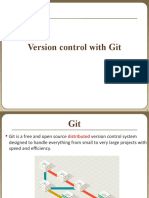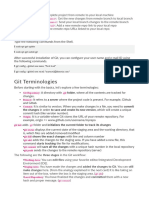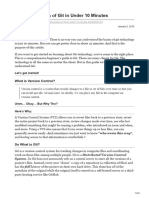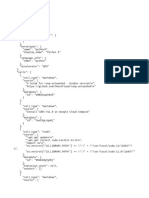The guide to Git I never had.
medium.com/@jake.page91/the-guide-to-git-i-never-had-a89048d4703a
Jake Page 11 de abril de 2024
Top highlight
Jake Page
Understanding Git
🩺 Doctors have stethoscopes.
🔧 Mechanics have spanners.
👨💻 We developers, have Git.
Have you noticed that Git is so integral to working with code that people hardly ever
include it in their tech stack or on their CV at all? The assumption is you know it already,
or at least enough to get by, but do you?
Git is a Version Control System (VCS). The ubiquitous technology that enables us to
store, change, and collaborate on code with others.
🚨 As a disclaimer, I would like to point out that Git is a massive topic. Git books
have been written, and blog posts that could be mistaken for academic papers too.
That’s not what I’m going for here. I’m no Git expert. My aim here is to write the Git
fundamentals post I wish I had when learning Git.
1/18
�As developers, our daily routine revolves around reading, writing, and reviewing code. Git
is arguably one of the most important tools we use. Mastering the features and
functionalities Git offers is one of the best investments you can make in yourself as a
developer.
So let’s get started
Git
🙏
If you feel I missed or should go into more detail on a specific command, let me
know in the comments below. And I will update this post accordingly.
While we are on the topic
If you are looking to put your Git skills to work and would like to contribute to Glasskube,
we officially launched in February and we aim to be the no-brainer, default solution for
⭐
Kubernetes package management. With your support, we can make it happen. The best
way to show your support is by starring us on GitHub
2/18
�Let’s lay down the foundations
Does Git ever make you feel like Peter Griffin?
If you don’t learn Git the right way you run the risk of constantly scratching your head,
getting stuck on the same issues, or rueing the day you see another merge conflict
appear in your terminal. Let’s ensure that doesn’t happen by defining some foundational
Git concepts.
3/18
� Git frustration
Branches
In a Git repository, you’ll find a main line of development, typically named “main” or
“master” (deprecated) from which several branches diverge. These branches represent
simultaneous streams of work, enabling developers to tackle multiple features or fixes
concurrently within the same project.
Git branch
Commits
4/18
�Git commits serve as bundles of updated code, capturing a snapshot of the project’s code
at a specific point in time. Each commit records changes made since the last commit was
recorded, all together building a comprehensive history of the project’s development
journey.
Git commits
When referencing commits you will generally use its uniquely identified cryptographic
hash.
Example:
git show abc123def456789
This shows detailed information about the commit with that hash.
Tags
Git tags serve as landmarks within the Git history, typically marking significant milestones
in a project’s development, such as releases, versions, or standout commits. These
tags are invaluable for marking specific points in time, often representing the starting
points or major achievements in a project's journey.
Git tags
HEAD
5/18
�The most recent commit on the currently checked-out branch is indicated by the HEAD,
serving as a pointer to any reference within the repository. When you're on a specific
branch, HEAD points to the latest commit on that branch. Sometimes, instead of pointing to
the tip of a branch, HEAD can directly point to a specific commit (detached HEAD state).
Stages
Understanding Git stages is crucial for navigating your Git workflow. They represent the
logical transitions where changes to your files occur before they are committed to the
repository. Let’s delve into the concept of Git stages:
Git stages
Working directory 👷
The working directory is where you edit, modify, and create files for your project.
Representing the current state of your files on your local machine.
Staging area 🚉
The staging area is like a holding area or a pre-commit zone where you prepare your
changes before committing them to the repository.
Useful command here: git add Also git rm can be used to unstage changes
Local repository 🗄️
The local repository is where Git permanently stores the committed changes. It allows
you to review your project’s history, revert to previous states, and collaborate with others
on the same codebase.
You can commit changes that are ready in the staging area with: git commit
6/18
�Remote repository 🛫
The remote repository is a centralized location, typically hosted on a server (like GitHub,
GitLab, or Bitbucket), where you can share and collaborate with others on your project.
You can use commands like git push and git pull to push/pull your committed
changes from your local repository to the remote repository.
Getting Started with Git
Well, you have to start somewhere, and in Git that is your workspace. You can fork or
clone an existing repository and have a copy of that workspace, or if you are starting
completely fresh in a new local folder on your machine you have to turn it into a git
repository with git init. The next step, crucially not to be overlooked is setting up your
credentials.
Source:
Credentials set up
When running pushing and pulling to a remote repository you don’t want to have to type
your username and password every time, avoid that by simply executing the following
command:
git config --global credential.helper store
The first time you interact with the remote repository, Git will prompt you to input your
username and password. And after that, you won’t be prompted again
7/18
� It’s important to note that the credentials are stored in a plaintext format within a
.git-credentials file.
To check the configured credentials, you can use the following command:
git config --global credential.helper
Working with branches
When working locally it’s crucial to know which branch you are currently on. These
commands are helpful:
git branch git branch feature-branch-name
To transition between branches use:
git
Additionally to transitioning between them, you can also use:
git checkout git checkout -b feature-branch-name
To check the repository’s state, use:
git status
A great way to always have a clear view of your current branch is to see it right in the
terminal. Many terminal add-ons can help with this. Here is one.
Terminal view
Working with commits
When working with commits, utilize git commit -m to record changes, git amend to modify
the most recent commit, and try your best to adhere to commit message conventions.
git commit -m
8/18
�If you have changes to your last commit, you don’t have to create another commit
altogether, you can use the - — amend flag to amend the most recent commit with your
staged changes
git add .git commit --amendgit push origin your_branch --force
⚠️ Exercise caution when utilizing --force, as it has the potential to overwrite the
history of the target branch. Its application on the main/master branch should be
generally avoided.
As a rule of thumb it’s better to commit more often than not, to avoid losing
progress or accidentally resetting the unstaged changes. One can rewrite the
history afterward by squashing multiple commits or doing an interactive rebase.
Use git log to show a chronological list of commits, starting from the most recent
commit and working backward in time
Manipulating History
Manipulating History involves some powerful commands. Rebase rewrites commit history,
Squashing combines multiple commits into one, and Cherry-picking selects specific
commits.
Rebasing and merging
It makes sense to compare rebasing to merging since their aim is the same but they
achieve it in different ways. The crucial difference is that rebasing rewrites the project’s
history. A desired choice for projects that value clear and easily understandable project
history. On the other hand, merging maintains both branch histories by generating a new
merge commit.
During a rebase, the commit history of the feature branch is restructured as it’s moved
onto the HEAD of the main branch
Git rebase
The workflow here is pretty straightforward.
9/18
�Ensure you’re on the branch you want to rebase and fetch the latest changes from the
remote repository:
git checkout your_branchgit fetch
Now choose the branch you want to rebase onto and run this command:
git rebase upstream_branch
After rebasing, you might need to force-push your changes if the branch has already
been pushed to a remote repository:
git push origin your_branch --force
⚠️ Exercise caution when utilizing --force, as it has the potential to overwrite the
history of the target branch. Its application on the main/master branch should be
generally avoided.
Squashing
Git squashing is used to condense multiple commits into a single, cohesive commit.
Git squashing
The concept is easy to understand and especially useful if the method of unifying code
that is used is rebasing, since the history will be altered, it’s important to be mindful of the
effects on the project history. There have been times I have struggled to perform a
squash, especially using interactive rebase, luckily we have some tools to help us. This is
my preferred method of squashing which involves moving the HEAD pointer back X
number of commits while keeping the staged changes.
git reset --soft HEAD~Xgit commit -m git push origin your_branch --force
⚠️ Exercise caution when utilizing --force, as it has the potential to overwrite the
history of the target branch. Its application on the main/master branch should be
generally avoided.
Cherry-picking
10/18
�Cherry-picking is useful for selectively incorporating changes from one branch to another,
especially when merging entire branches is not desirable or feasible. However, it’s
important to use cherry-picking judiciously, as it can lead to duplicate commits and
divergent histories if misapplied
Git cherry-pick
To perform this first you have to identify the commit hash of the commit you would like to
pick, you can do this with git log. Once you have the commit hash identified you can
run:
git checkout target_branchgit cherry-pick <commit-hash> git push origin
target_branch
Advanced Git Commands
Signing commits
Signing commits is a way to verify the authenticity and integrity of your commits in Git. It
allows you to cryptographically sign your commits using your GPG (GNU Privacy Guard)
key, assuring Git that you are indeed the author of the commit. You can do so by creating
a GPG key and configuring Git to use the key when committing. Here are the steps:
gpg --gen-keygit config --global user.signingkey <your-gpg-key-id>git commit -S -m
git --show-signature
Git reflog
A topic that we haven’t explored is Git references, they are pointers to various objects
within the repository, primarily commits, but also tags and branches. They serve as
named points in the Git history, allowing users to navigate through the repository’s
timeline and access specific snapshots of the project. Knowing how to navigate git
references can be very useful and they can use git reflog to do just that. Here are some of
the benefits:
Recovering lost commits or branches
11/18
� Debugging and troubleshooting
Undoing mistakes
Interactive rebase
Interactive rebase is a powerful Git feature that allows you to rewrite commit history
interactively. It enables you to modify, reorder, combine, or delete commits before
applying them to a branch.
In order to use it you have to become familiar with the possible actions such are:
Pick (“p“)
Reword (“r“)
Edit (“e“)
Squash (“s“)
Drop (“d“)
Git interactive rebase
Here is a useful video to learn how to perform an interactive rebase in the terminal, I have
also linked a useful tool at the bottom of the blog post.
Collaborating with Git
Origin vs Upstream
The origin is the default remote repository associated with your local Git repository when
you clone it. If you’ve forked a repository, then that fork becomes your “origin” repository
by default.
12/18
�Upstream on the other hand refers to the original repository from which your repository
was forked.
To keep your forked repository up-to-date with the latest changes from the original
project, you git fetch changes from the “upstream” repository and merge or rebase them
into your local repository.
To see the remote repositories associated with you local Git repo, run:
git remote -v
Conflicts
Don’t panic, when trying to merge or rebase a branch and conflicts are detected it only
means that there are conflicting changes between different versions of the same file or
files in your repository and they can be easily resolved (most times).
Git merge
They are typically indicated within the affected files, where Git inserts conflict markers
<<<<<<<, ======= and >>>>>>> to highlight the conflicting sections. Decide which
changes to keep, modify, or remove, ensuring that the resulting code makes sense and
retains the intended functionality.
After manually resolving conflicts in the conflicted files, remove the conflict markers
<<<<<<<, =======, and >>>>>>> and adjust the code as necessary.
Save the changes in the conflicted files once you’re satisfied with the resolution.
If you have issues resolving conflicts, this video does a good job at explaining it.
Popular Git workflows
13/18
� Git workflows
Various Git workflows exist, however, it’s important to note that there’s no universally
“best” Git workflow. Instead, each approach has its own set of pros and cons. Let’s
explore these different workflows to understand their strengths and weaknesses.
Teamwork
Feature Branch Workflow 🌱
Each new feature or bug fix is developed in its own branch and then merge it back into
the main branch once completed.
Isolation of changes and reducing conflicts.
Can become complex and require diligent branch management.
Gitflow Workflow 🌊
14/18
�Gitflow defines a strict branching model with predefined branches for different types of
development tasks.
It includes long-lived branches such as main, develop, feature branches, release
branches, and hotfix branches.
Suitable for projects with scheduled releases and long-term maintenance.
Can be overly complex for smaller teams
Forking Workflow 🍴
In this workflow, each developer clones the main repository, but instead of pushing
changes directly to it, they push changes to their own fork of the repository. Developers
then create pull requests to propose changes to the main repository, allowing for code
review and collaboration before merging.
This is the workflow we use to collaborate on the open-source Glasskube repos.
Encourages collaboration from external contributors without granting direct write
access to the main repository.
Maintaining synchronization between forks and the main repository can be
challenging.
Pull Request Workflow ⏩
Similar to the Forking Workflow, but instead of forking, developers create feature
branches directly in the main repository.
Facilitates code review, collaboration, and knowledge sharing among team
members.
Dependency on human code reviewers can introduce delays in the development
process.
Trunk-Based Development 🪵
If you are on a team focused on rapid iteration and continuous delivery, you might use
trunk-based development which developers work directly on the main branch committing
small and frequent changes.
Promotes rapid iteration, continuous integration, and a focus on delivering small,
frequent changes to production.
Requires robust automated testing and deployment pipelines to ensure the stability
of the main branch, may not be suitable for projects with stringent release
schedules or complex feature development.
What the fork?
15/18
�Forking is highly recommended for collaborating on Open Source projects since you have
complete control over your own copy of the repository. You can make changes,
experiment with new features, or fix bugs without affecting the original project.
💡 What took me a long time to figure out was that although forked repositories
start as separate entities, they retain a connection to the original repository. This
connection allows you to keep track of changes in the original project and
synchronize your fork with updates made by others.
That’s why even when you push to your origin repository. Your changes will show up on
the remote also.
Git Cheatsheet
16/18
�# Clone a Repository
git clone <repository_url>
# Stage Changes for Commit
git add <file(s)>
# Commit Changes
git commit -m "Commit message"
# Push Changes to the Remote Repository
git push
# Force Push Changes (use with caution)
git push --force
# Reset Working Directory to Last Commit
git reset --hard
# Create a New Branch
git branch <branch_name>
# Switch to a Different Branch
git checkout <branch_name>
# Merge Changes from Another Branch
git merge <branch_name>
# Rebase Changes onto Another Branch (use with caution)
git rebase <base_branch>
# View Status of Working Directory
git status
# View Commit History
git log
17/18
�# Undo Last Commit (use with caution)
git reset --soft HEAD^
# Discard Changes in Working Directory
git restore <file(s)>
# Retrieve Lost Commit References
git reflog
git rebase --interactive HEAD~
Bonus! Some Git tools and resources to make your life easier.
for interactive rebasing.
to view colorful, incremental diffs.
Interactive Git branching
🙏
If you like this sort of content and would like to see more of it, please consider supporting
us by giving us a Star on GitHub
Give us a GitHub star if you feel so inclined.
18/18



























































































